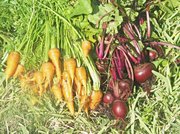Root crops are not as significant a part of the diet in the Bahamas as they are in Europe and North America where they once were essential to survival in the winter months because of their long keeping qualities.
Carrots love fertile sandy loam and should not be planted where compost has been recently applied as that tends to promote side shoots. Old compost that has been fully incorporated into the soil over time is fine. The seeds should be sown in blocks allowing 2 inches between plants and successive sowing every three weeks will keep carrots coming throughout the cooler months.
There are several types of carrot: nantes, kuroda, chantenay, danvers and imperator. The last mentioned is by far the largest and should only be grown where soil is 18 inches to two feet deep. That does not sound like the Bahamas to me. The other types need a depth of around about 12 inches to grow unimpeded to full size.
Early thinning can be taken to provide a gourmet side vegetable. Do not confuse baby carrots like these with so-called baby carrots you buy in the food store. The store-bought ones are sculpted from old, large carrots to a convenient size.
Unfortunately, the carrots we grow do not attain the degree of sweetness achieved in cooler climates. They are tasty, however, and we should make more use of carrots as a plated vegetable rather than as a minor addition to soups, stews and slaws.
Beets do grow sweet in the Bahamas, especially if picked early just as they are approaching full size. There is little virtue in a large beet. The standard beet for many years has been Detroit Red and that is the variety I recommend. You can find pink, white and yellow beets, but you have to ask yourself why. There are also beets that are cylindrical.
The big choice with beets is whether to serve them sweet or in vinegar sauce. You may wish to try them with a dollop of sour cream. Do not forget that beet greens are probably the tastiest of all greens.
Parsnips are a very marginal crop in our climate and do not reach their full potential. I will grow some this winter because somebody brought a packet all the way from Britain for me.
Parsnips have a long germination period, usually three weeks, and grow in similar conditions to carrots. They taste best when roasted, especially alongside a joint of beef.
Radishes are the easiest of vegetables to raise, and the fastest. Their peppery taste is either liked or hated. Radishes are rarely encountered in Bahamian cuisine but if you do grow some, try throwing a few into a stew. The pepperiness disappears and the taste is very similar to turnips.
Rutabagas and turnips are both easily grown in moderately fertile soil. Rutabagas grow quite large – softball size – and can be boiled, pureed, and added to mashed potatoes. Turnips should be harvested just before maturity. I do not care for them so I leave you to dispense with them as you wish.
I do like sweet potatoes but I do not have the sandy soil in my yard that they require. Sweet potatoes are grown from slips that appear from old harvested potatoes. The slips should have the bottom two inches or so planted and be kept well watered until roots have established themselves. Thereafter, sweet potatoes are a carefree crop that needs little in the way of attention. It is advised that nitrogen not be given to sweet potatoes as it promotes leaf growth instead of roots growth. Boniato or Cuban sweet potato is the finest variety.
Aren’t onions and Irish potatoes root crops? They are, but we will deal with them later. Plant scallions and leeks now but wait until December before planting heading onions.
• j.hardy@coralwave.com





Comments
Use the comment form below to begin a discussion about this content.
Sign in to comment
Or login with:
OpenID